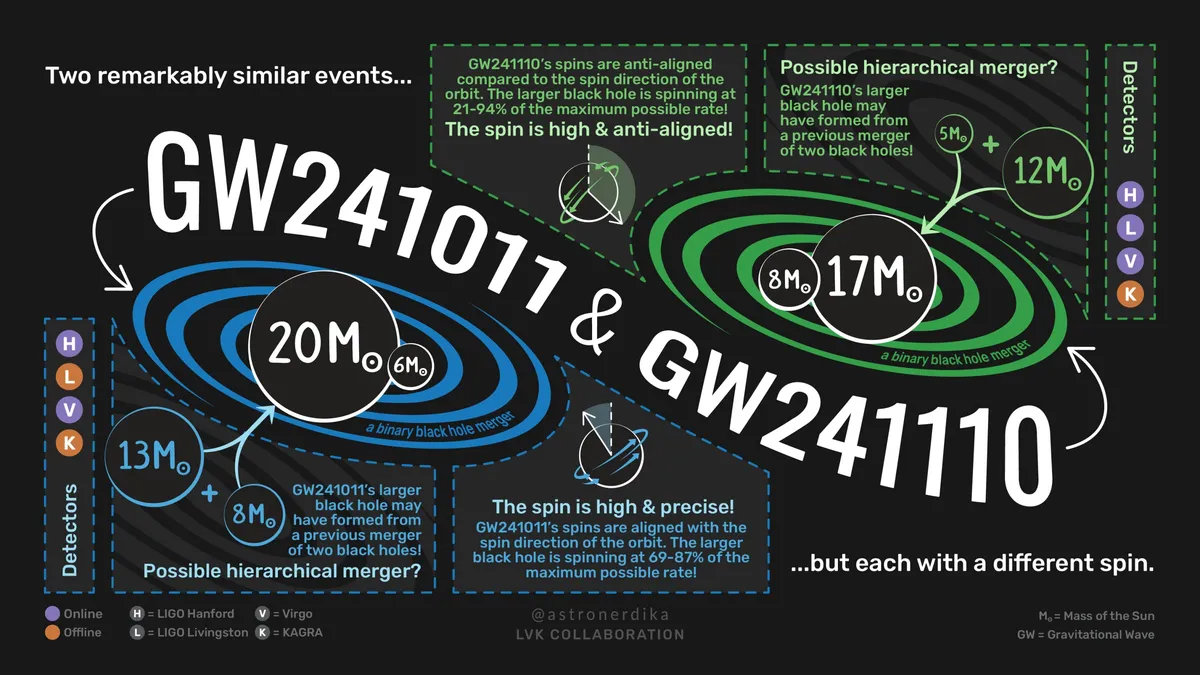
In a significant breakthrough for astrophysics, the LIGO-Virgo-KAGRA Collaboration has reported the detection of two distinct gravitational wave events occurring in October and November of 2024. This remarkable observation, detailed in a paper published in The Astrophysical Journal Letters, unveils new insights into the enigmatic phenomena of black holes and their spins, further enhancing our understanding of the universe.
Gravitational waves are ripples in the fabric of space-time, generated by catastrophic events in the cosmos, such as the collision of massive black holes. The LIGO-Virgo-KAGRA Collaboration utilizes advanced algorithmic techniques and mathematical modeling to analyze these waves, allowing researchers to reconstruct various physical attributes of the detected black holes. This includes their masses, distances from Earth, and even their rotational speeds and orientations, commonly referred to as spin.
The first merger, designated as GW241011, was detected on October 11, 2024, approximately 700 million light years away. This event resulted from the collision of two black holes, with masses around 17 and 7 times that of the Sun. Notably, the larger black hole in this merger was identified as one of the fastest rotating black holes ever observed. The second event, GW241110, was detected nearly a month later on November 10, 2024, originating from about 2.4 billion light years away and involving black holes with masses of approximately 16 and 8 solar masses. Intriguingly, the primary black hole in GW241110 was found to be spinning in the opposite direction of its orbit—an unprecedented observation in gravitational wave astronomy.
Each detection of gravitational waves not only represents a significant astrophysical discovery but also serves as a vital laboratory for examining the fundamental laws of physics. According to paper co-author Carl-Johan Haster, an assistant professor of astrophysics at the University of Nevada, Las Vegas (UNLV), these observations suggest the potential existence of second-generation black holes. Both GW241011 and GW241110 provide compelling evidence of hierarchical mergers, where black holes formed from previous mergers coalesce in dense environments, such as star clusters.
The extraordinary capabilities of global gravitational wave observatories underscore the importance of international collaboration in exploring the universe's mysteries. Gianluca Gemme, spokesperson of the Virgo Collaboration, emphasizes that the unusual spin configurations observed in these events challenge existing theories of black hole formation while suggesting that some black holes are not isolated entities but part of more complex systems within the cosmos.
The concept of gravitational waves was first introduced by Albert Einstein in 1916 as part of his general theory of relativity, but it wasn't until 2015 that the first direct detection was made by the LIGO and Virgo collaborations. Currently, the LIGO-Virgo-KAGRA network is in its fourth observing run (O4), which began in May 2023 and is set to conclude in November 2023. To date, approximately 300 black hole mergers have been observed, with ongoing analyses yielding further insights into the nature of these cosmic events.
The precision with which GW241011 was measured allowed researchers to test key predictions of Einstein's theory of general relativity under extreme conditions. The rapid rotation of the black hole slightly distorts its shape, leaving a distinct signature in the gravitational waves emitted. The research team found an excellent correlation with Roy Kerr's solution for rotating black holes, reaffirming Einstein's predictions with unprecedented accuracy. This event also allowed scientists to observe higher harmonics in the gravitational wave signal for only the third time, further validating Einstein’s theories.
The rapidly rotating black holes observed in this study may also provide insights into particle physics. Researchers can utilize these black holes to test the existence and mass of hypothesized ultralight bosons—particles that could potentially interact with black holes. The continued rapid rotation of the massive black hole in GW241011 suggests that a range of ultralight boson masses can be ruled out, opening new avenues for exploration in the field of particle physics.
The detections of GW241011 and GW241110 highlight the importance of enhancing the sensitivity of gravitational wave detectors and operating them in synergy. As Francesco Pannarale, professor at Sapienza—University of Rome, notes, these findings deepen our understanding of how black hole binaries can form and the fundamental physics governing their interactions. With ongoing upgrades to detection instruments, researchers are poised to make even more groundbreaking discoveries in the near future.